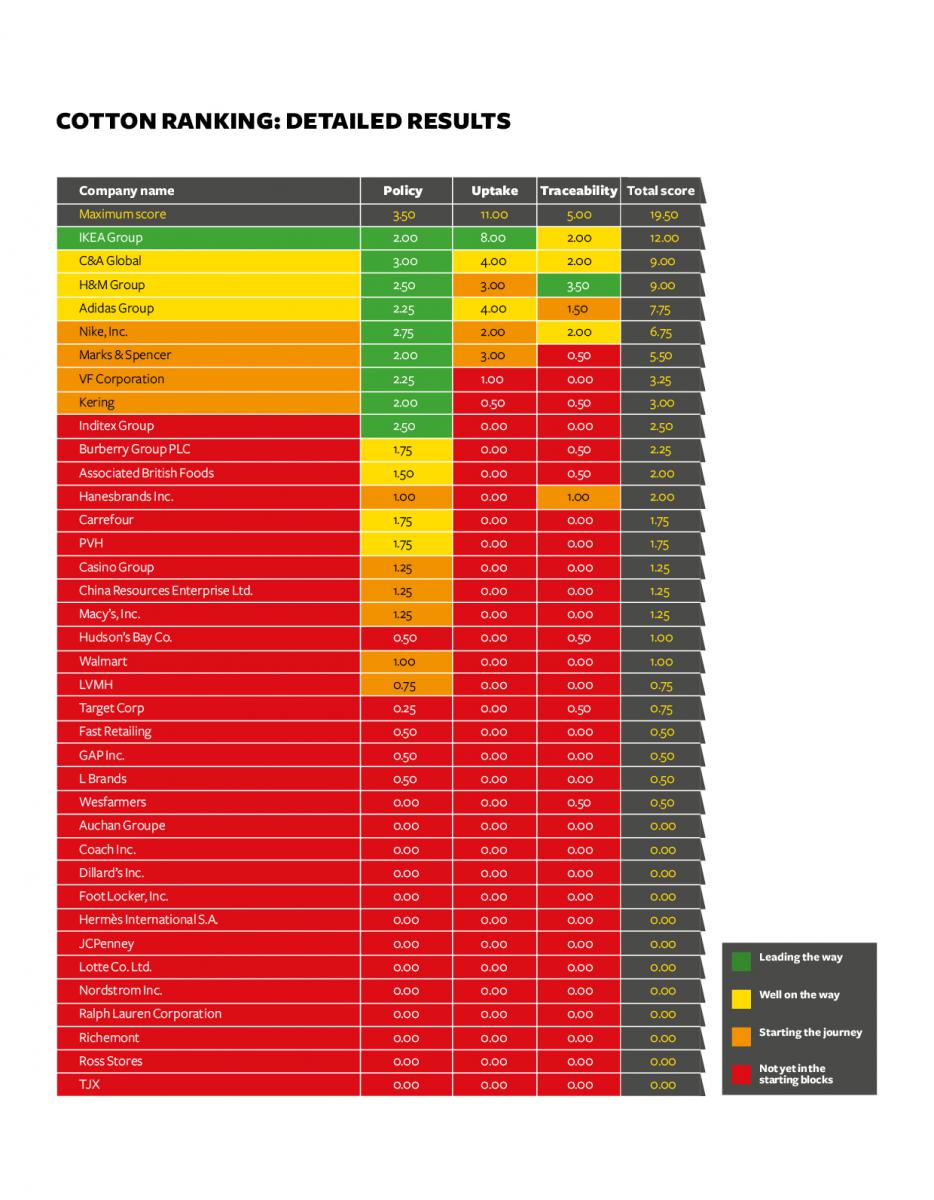Utrecht, The Netherlands, 2016-Jun-08 — /EPR Retail News/ — The majority of international companies using most cotton globally are failing to deliver on cotton sustainability according to new independent research published today by Pesticide Action Network (PAN) UK, Solidaridad and WWF.
Just eight companies out of 37 made it out of the red zone in the ranking researchconducted by Rank a Brand, one of Europe’s largest brand-comparison sites on sustainability and corporate social responsibility. Only home furnishing giant IKEA, who top the ranking, score in the green zone with 12 out of a maximum of 19.5 points. C&A (9), H&M (9) and Adidas (7.75) follow in the yellow zone, while Nike (6.75), M&S (5.5), VF Corporation (3.25), and Kering (3) are in the orange zone. Another 29 companies fall in the red zone and appear to do virtually nothing on cotton sustainability.
 LACK OF DEMAND FROM TOP BRANDS
LACK OF DEMAND FROM TOP BRANDS
“IKEA, C&A and H&M are showing how cotton sustainability is good for business but many top companies are failing to deliver”, said Richard Holland, WWF. “Sourcing more sustainable cotton has never been easier so there is no excuse for companies not to offer more responsible products to customers.”
“It’s clear that just a few leading companies are doing the heavy lifting on sourcing sustainable cotton”, said Isabelle Roger, Solidaridad. “For the cotton sector as a whole to become sustainable, all other major companies will need to get on board.”
While around 10-13 per cent of global cotton supply can be classed as more sustainable, less than a fifth of this amount is actually being used as more sustainable cotton in products with the rest being sold as conventional due to lack of demand from top brands and companies.
“Lack of uptake of more sustainable cotton is a massive missed opportunity”, said Keith Tyrell, PAN UK. “Conventional cotton production often suffers from serious social and environmental impacts such as excessive water and hazardous pesticide use. Growing the sustainable cotton market is our best chance of cleaning up cotton and protecting worker health.”
COMPANY PERFORMANCE ACROSS THREE AREAS
Rank a Brand scored company performance across three areas: policy, sourcing and use, and traceability. Most points were available for sourcing and use with companies assessed according to volumes used from Better Cotton, Cotton made in Africa, Organic, and Fairtrade – the four standards judged to be sustainable for this research.
PAN UK, Solidaridad and WWF are calling on all companies using large volumes of cotton to set, report and deliver on time-bound targets for cotton sustainability – companies serious about sustainability should be sourcing 100% more sustainable cotton by 2020 at the latest.
SUSTAINABLE COTTON REPORTS
The full Cotton Ranking report and a cotton market briefing, ‘Mind the Gap: Towards a More Sustainable Cotton Market’ give an overview of the market for more sustainable cotton.
37 companies estimated globally to use the most cotton in their products were scored across sustainable cotton policy, sourcing and use, and traceability. As transparency and accountability are considered paramount by PAN UK, Solidaridad and WWF, only publicly available information was used in scoring company performance. In general, there is still a significant lack of information on sustainable cotton policies, sourcing, and supply chain transparency.
The four standards deemed most credible in this research as assessed by the WWF Certification Assessment Tool are: Better Cotton, Cotton made in Africa, Organic, and Fairtrade.
COTTON GLOBALLY
Cotton is grown in around 80 countries worldwide and is a key raw material for the textile industry, accounting for around 32% of all fibres used. Sustainability issues include the widespread use of pesticides, with 6.2% of global pesticide sales associated with cotton production (which uses just 2.3% of the world’s arable land), and intensive water use, with 73% of global production currently dependent on irrigation.
While many smallholder cotton farmers are driven into debt by the cost of pesticides and fertilisers, sustainable cotton production has the potential to lift farmers out of poverty by providing a more stable income and improving working conditions.
A number of sustainable cotton standards have been developed in the last 30 years, starting with Organic cotton in the 1980s, followed by Fairtrade in 2004, Cotton made in Africa (CmiA) in 2005 and the Better Cotton Initiative (BCI) in 2009. All provide guidance and support for farmers and seek to reassure consumers and retailers that the products they buy are being produced using sustainable farming methods.
The supply of sustainable cotton has never been greater (estimated to be at 13 per cent of global supply in 2015) but uptake by companies, essential for mainstreaming sustainable cotton, remains too low at approximately 17 per cent of what is available. Reasons for low uptake given by companies include low consumer demand, complexity of their supply chains and additional costs. Low uptake risks demotivating farmers and hindering lasting change in the textile sector.
CONTACT INFORMATION
Isabelle Roger
Global Cotton Programme Manager
###
